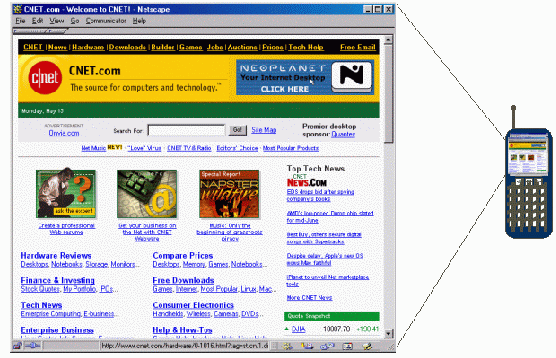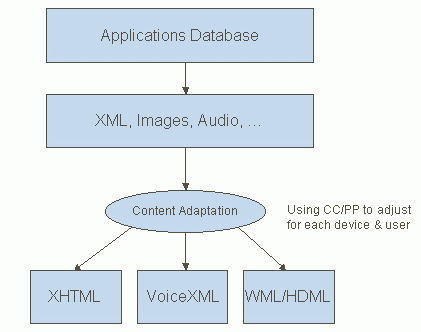Device Independent Authoring
Is it realistic?
Dave Raggett, W3C/HP
W3C Workshop, Bristol, 3rd October 2000
Email: dsr@w3.org
W3C Activity Lead for Voice Browsers, XHTML and XForms
Email: dsr@w3.org
W3C Activity Lead for Voice Browsers, XHTML and XForms
1989 – CERN WWW Project Proposal
1993 Mosaic gets off the ground
1994 Netscape blasts into action
1995 Java; Bill Gates gets the message
Late 90’s sees Dot Com Frenzy
TV and Mobile join the fray
Voice Interaction is white hot …
In the beginning, there was Unix, X11 and VT100 terminals
Windows (and Macs) take over
Digital Television
WAP and iMode
The mighty Palm
The plain old telephone

Creating mobile services by extracting information from existing web pages
Amounts to an expert system
The problem is you need to guess the author’s intent
Brittle – it fails if pages change unexpectedly
The content owner needs to be involved
Desktops great for imagery, animation and lots of content, emphasis on browsing
Television – lower resolution and emphasis on entertainment and shorter attention span
Cell Phones – task centric, very focused, with emphasis on mobility
The Future is Multi-Modal!
Many of us will suffer from one form or another of sensory impairment in our lifetimes
We are all very busy, but laziness is not an option when it comes to accessibility!
Preserving intention is the key to success
It all boils down to text
Couldn’t we just use HTML?
Pure form of single authoring is considered impractical except for the lowest common denominator, which fails to meet the content providers needs with respect to end-users.
Not going to be solved by one language.

Writers of pure content – e.g. journalists who send in their copy with no regard to layout/presentation
Editors – who select and adjust content to set the overall tone
Graphics designers – who create the look and feel
Sound artists – who do the same for audio
Marketing wizards – defenders of the brand
Back room geeks – who weave the technical magic that makes it all work
HTML focuses on Web pages
Applications usually span multiple pages
Cell phones need smaller pages (cards)
Voice needs dialogs (speak, listen, act)
Authors think in terms of applications
Let’s think in terms of Plans & Goals, and ways to realize these effectively for each platform
A vision for an authoring environment for delivery to multiple platforms!
Big Web sites produce hundreds or thousands of pages daily, with extensive effort on customization/personalization
A huge team of worker bees
Lots of resources, and lots of experience
Can afford to develop custom publishing solutions
Vast numbers of people with little time, or knowledge about the intricacies of the Web
One person has to do many jobs
Wizards can substitute for lack of skills
Mass-produced authoring systems can build on design patterns discovered by large scale publishers
Our mantra – separating content from presentation
CSS @media for tuning style to media
Mobile Profile
Printing
XSLT and Scripts for transformations
CC/PP for describing device capabilities
XForms – separating UI from data
It should be easy as possible to write and maintain content for multiple modalities/devices.
Authors must be able to control the presentation for specific modalities/devices. But this not required in all applications.
It shouldn't be more work to use this solutions/tool than writing separate pages for each modality/device
Abstract models/device classes help to reduce the complexity in tailoring content.
The semantics need to be present in the raw content in order for a transformational approach to be able to tailor the content to best suit particular modalities/device classes.
Application model has to address state, interaction and transactions. Not all applications will use all of these.
One approach is to embed information about presentation and interaction into the content. Hints and graceful degradation models are used to tailor to particular modalities/devices.
Constraint-based mechanisms can simplify the task of the author by pushing the burden back on the implementers.
Break out sessions to brainstorm issues
30 minutes to collect ideas on the challenges and promising directions for device independent authoring
First select your leader, who will also be responsible for reporting back to the plenary
Summarize results on a transparency
Rank according to urgency & long term significance